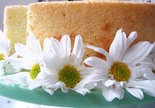
In 1948 Betty Crocker introduced the chiffon cake to America where it was hailed as "the cake discovery of the century!" Up to this point in cake history there were either light sponge cakes or the heavier butter or shortening cake. Chiffon cakes were a wonder to all home bakers as they mysteriously combined the richness of the butter cake with the light spring of an angel food or sponge cakes resulting in a more moist cake.
A California insurance salesman, Harry Baker invented the recipe in 1927. He baked his cakes in the Los Angeles area and for Hollywood restaurants such as the Brown Derby. Although many asked for it he never divulged the secret recipe. Mr. Baker (how appropriate is the name!) decided that Betty Crocker should share the recipe with the women of America. The recipe first appeared in the May 1948 Better Homes and Garden Magazine.
The secret? Chiffon cake owes its unique texture to the use of vegetable oil instead of butter which has an effect on the oil on the foam structure of the beaten egg whites used in this cake.
Foam cakes have a high proportion of eggs to flour, contain very little, if any, fat and have a spongy, light and airy texture. The result is an elegant, light as a cloud cake. There are three categories of foam cakes those that contain fat--genoises and chiffons--the fat comes from melted butter or oil plus egg yolks. Second are cakes with no fat such as angel food cakes (Rockefeller Chocolate Angel Cake), meringues (Lemon Meringue Pie-Texas Style) and dacquoises. And lastly those where the fat is present by egg yolks only such as sponge cakes (my Limoncello Torta) and some biscuits and roulades.
As with angel food cakes, this cake should be cooled upside down to maintain its full height. You can use a tube pan with raised tabs on the side or a tube pan with a raised center column that is higher than the sides. This recipe makes a large cake, enough for 16 to 20 slices. It also freezes well, and although I haven't tried this I imagine it would also be a good base for Baked Alaska or as a filled cake that need to be served cold. This cake keeps it's texture in the fridge--due to the lack of butter or shortening.
A final note, during the last Sugar High Friday I had experienced an egg white collapse. In this recipe whipped stiff peaks of egg whites are a key to success I noted that cream of tartar was called for. This powder is a tartaric acid and is a fine white crystalline acid salt is a natural by-product of the wine-making industry. It is used in the whipping of egg whites to stabilize and allow them to reach maximum volume. And boy did they! Oh the joy of baking science. I now feel confident enough to move on to a very dramatic lemon meringue pie.
Note: If you are beating eggs whites and don't have cream of tartar, you can substitute white vinegar (in the same ratio as cream of tartar, generally 1/8 teaspoon per egg white. OChef.com
Cooking Light, JUNE 2005
Note: It is absolutely necessary to weigh the flour and sugar. It's your only guarantee for a billowy, elegant cake that's light and airy. I also had the egg whites at room temperature. I was also surprised that this recipe worked--CL doesn't always deliver but this recipe rates as a keeper! The orange flavor is not overpowering. Serve with berries and whipped cream.
Ingredients:
1 1/2 teaspoons baking powder
1/2 teaspoon salt
8 ounces granulated sugar (about 1 cup), divided
6 ounces sifted cake flour (about 1 3/4 cups)
1 tablespoon grated orange rind
1/2 cup fresh orange juice (about 1 orange)
1 tablespoon grated lemon rind
5 tablespoons canola oil
1 1/2 teaspoons vanilla extract
3 large egg yolks
8 large egg whites
3/4 teaspoon cream of tartar
2 teaspoons powdered sugar
Preheat oven to 325°.
Combine baking powder, salt, 7 ounces sugar, and flour in a large bowl, stirring with a whisk until mixture is well combined. Note--I triple-sifted these ingredients--I'm not taking any chances!
Combine orange rind and next 5 ingredients (through egg yolks) in a medium bowl, stirring with a whisk. Add rind mixture to flour mixture, stirring until smooth.
Place egg whites in a large bowl; beat with a mixer at high speed until foamy. Add cream of tartar; beat until soft peaks form. Gradually add remaining 1 ounce sugar, beating until stiff peaks form. Gently stir one-fourth of egg white mixture into flour mixture; gently fold in remaining egg white mixture.
Spoon batter into an ungreased 10-inch tube pan, spreading evenly. Break air pockets by cutting through batter with a knife. Bake at 325° for 45 minutes or until cake springs back when lightly touched. Invert pan; cool completely. Loosen cake from sides of pan using a narrow metal spatula. Invert cake onto plate. Sift powdered sugar over top of cake.
Yield: 16 servings (serving size: 1 slice)
CALORIES 158(30% from fat); FAT 5.3g (sat 0.6g,mono 3g,poly 1.5g); FIBER 0.3g; CARBOHYDRATE 24.2g WW Points = 4



That looks delicious - and such an informative post, too! Who would have thought that an insurance salesman had it in him?
Posted by: melissa | June 27, 2005 at 07:27 AM
Great post! Informative and tasty.
Posted by: Nic | June 27, 2005 at 02:45 PM